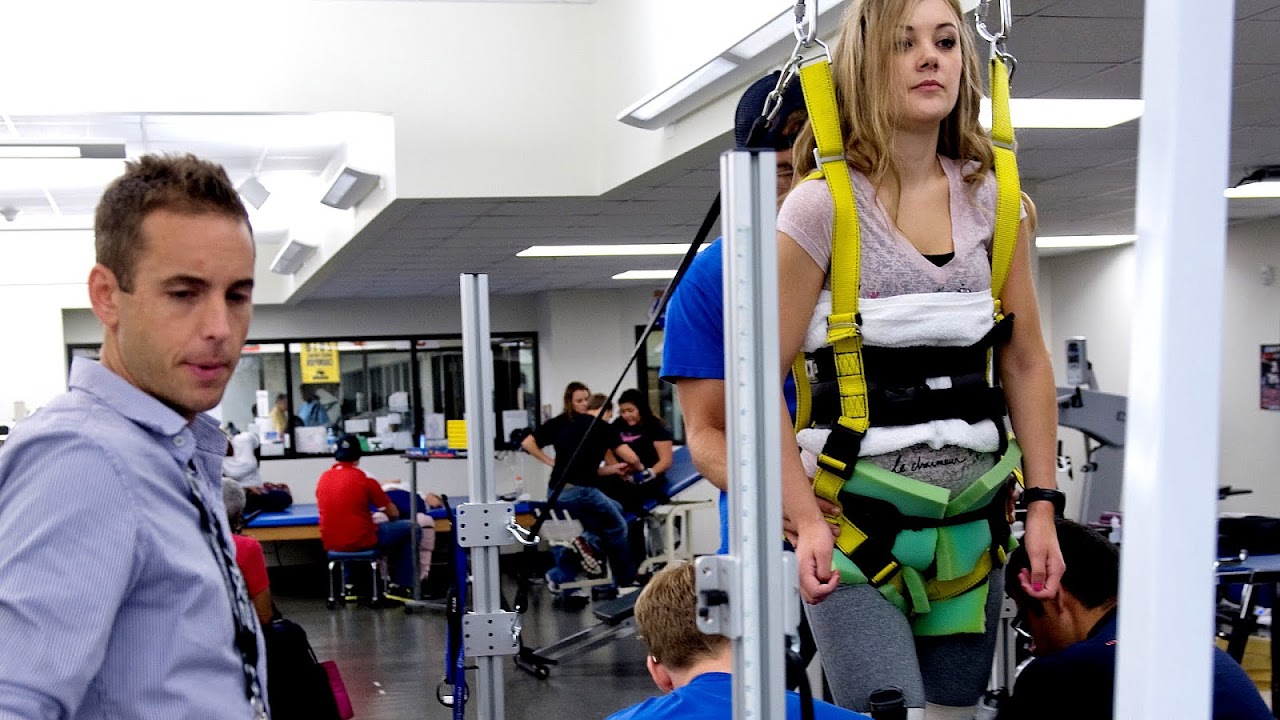
Gait training or gait rehabilitation is the act of learning how to walk, either as a child, or, more frequently, after sustaining an injury or disability. Physical therapists, or physiotherapists, generally help their patients with gait training.
Gait training can take a number of forms, but repetition of the actual motions performed during walking is the most important factor. Parallel bars may be used to help with gait training, especially in the early stages when a patient is first learning or re-learning to walk. They involve a person walking between two handrails to support themselves, often with the therapist either helping to support the patient or physically moving the patient's legs. Gait trainer or other gait aids are also utilized.
In recent years there have been advancements in how the patient can increase the duration of therapy safely to make for more effective treatment. Body-weight support (BWS) systems or unweighting devices are starting to become more and more popular and have been the subject of much study. BWS systems can be used prior to the patient gaining adequate motor control or having sufficient strength to fully bear weight. The patient will wear a specialized trunk harness with adjustable straps, which attach to an overhead suspension system. The harness and its attachments support a certain amount of the patient's body weight. Gait training techniques that utilize a BWS system appear to be promising in their ability to improve and possibly restore walking function, as demonstrated in individuals suffering from incomplete spinal cord injuries. A BWS system can be used on a treadmill or over ground for gait training. Body-weight-supported treadmill training (BWSTT) enables individuals with motor deficits that have rendered them incapable of completely supporting their own body weight to practice and experience locomotion at physiological speeds. Depending on the severity of the person's impairment, one or more physiotherapists may be present to assist in maintaining the patient's appropriate posture and moving their legs through as kinematically physiological a gait pattern as possible. Recently, electromechanical devices such as the Hocoma Lokomat robot-driven gait orthosis have been introduced with the intention of reducing the physical labour demands on therapists. This system uses a computer-controlled exoskeleton to repeatedly and consistently guide lower-limb movements, making BWSTT a more feasible option for long-term and widespread use.
Another device category, so-called end-effector gait trainers, activates the human gait pattern over moving foot-plates as opposed to an orthosis. The German society for Neurorehabilitation has recently recommended end-effector devices for gait rehabilitation after stroke due to current medical evidence.
Treadmill training, with or without a body-weight support, is an emerging therapy and is being used with stroke patients to improve kinematic gait parameters. These patients often present with significant gait deviations and body weight-supported treadmill training can provide an intense repetitive practice of a more natural gait pattern. Literature continues to emerge examining the influence treadmill speed may have on the improvement of gait patterns and functional independence. Research has shown that a greater gain in independent walking ability is seen in hemiparetic stroke patients who participate in structured speed-dependent treadmill training compared to conventional training. Improvements in gait parameters included walking speed, cadence, stride length and Functional Ambulation Category scores. In speed-dependent treadmill training, belt speed is increased to the maximum-achievable speed the patient can maintain for 10 seconds without stumbling, followed by a period of recovery. If the patient were capable of maintaining the speed safely and comfortably during the 10-second bout, it would then be increased by 10% in the next attempt, following the same work and recovery procedures. Research has shown that this form of gait training demonstrates a more normal walking pattern without the compensatory movements commonly associated with stroke.
Although gait training with parallel bars, treadmills and support systems can be beneficial, the long-term aim of gait training is usually to reduce patients' dependence on such technology in order to walk more in their daily lives.
Gait training can be useful for people with the following conditions:
- Amputation
- Osteoarthritis
- Muscular dystrophy
- Cerebral palsy
- Stroke
- Parkinson's disease
- Multiple sclerosis
- Brain and spinal cord injuries
- After surgery
- Sports injury
Gait training for neurologic patients -also called locomotion therapy- many times is performed on treadmills while 2 therapists assisting the patients leg to move forward step by step. This is extremely exhausting for the therapists who many times have unergonomic working position and thus not only suffering from fatigue but also from back and shoulder pain. Help is given by a very reasonable priced new gait training and gait correction system called robowalk expander, designed and launched by h/p/cosmos sport & medical gmbh in Germany. robowalk allows to reduce required therapists from 2 to only 1 and the power and labour intensive task is done by expander cables. How does the new h/p/cosmos robowalk® expander work? First, elastic cables are attached to patient´s legs with comfortable leg cuffs. As the patient walks, the cables at the front assist the movement of the legs with support. The cables at the rear can be used also as resistance and for gait correction training. Both the front and back system can be utilized together for even greater training effects. By adjusting the angle of the support/resistance cables either vertically or horizontally, movement correction is possible. The patented tension adjustment module involves readable scales on each cable for tension monitoring. - gait training and gait correction for orthopaedic or neurological patients - gait improvement - motion support - mobilization of spastic patients - supports therapists in manual locomotion therapy - strength and coordination training
Source of the article : Wikipedia


EmoticonEmoticon